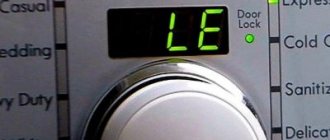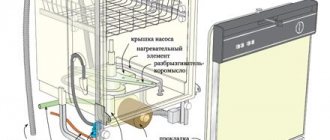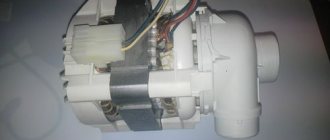How to care for your dishwasher?
To extend the life of a household appliance, you need to learn how to properly care for it. The user must constantly clean the filter elements from accumulated debris, as well as rinse the basket, remove scale and rust.
Every 20 rinsing cycles, the unit is washed with a degreaser or citric acid, and significant deposits are removed manually. Do not leave blockages inside the household appliance; dirt accumulations are removed using a thin wire bent with a hook.
You can remove mold using bleach, but this product is not recommended for use on equipment whose drum is made of stainless steel. A similar treatment is done without adding dishes at low speeds for 10 minutes. Rust on a household appliance is treated with sealant or coated with paint.
A well-maintained car means clean dishes.
Various stains inevitably appear even if the machine itself is not working properly. The following factors may be the cause of the failure:
- Dirt accumulated inside the dishwasher. To get rid of it, just start the washing mode without dishes, using special cleaning products. For the same purpose, you can use regular citric acid.
- Calcified deposits on cutlery often indicate clogged filters. In such cases, they need to be replaced or cleaned.
- If you use the machine strictly according to the instructions, and white deposits still appear, you should pay attention to the operation of the sensor, which determines the level of water hardness. To diagnose this type of malfunction, it is best to call a specialist. A similar problem will arise if the ion exchanger breaks down.
- In some Chinese-assembled units, the compartment lid may not fit well, as a result of which it does not close tightly. In such cases, it is better to replace the compartment itself or adjust its operation. Otherwise, avoiding the appearance of white spots on the dishes will be quite problematic.
- A characteristic coating also appears when the machine is overloaded with cutlery or is placed incorrectly, which significantly complicates the rinsing process.
- Regenerating salt, which is used to soften water, should be poured strictly into the ion exchanger. If the product spills or gets into the machine through a poorly closed lid, a white coating may appear on the dishes.
- In order to avoid corrosion, experts advise adding salt immediately before starting the machine. If this substance gets into the ion exchanger, and you do not plan to load dishes yet, you can start the unit using the shortest program.
- Not only hard, but also very soft water contributes to the formation of characteristic stains. In such cases, it is also necessary to set the optimal quality parameters using the instructions.
- It is necessary to load dishes that have been cleared of food into the machine, because clogged filters make draining the water much more difficult. As a result, the resulting scale can settle on internal parts, preventing the free spray of the water jet. This automatically reduces the quality of dishwashing.
The machine will ideally perform the established functions if during its operation all the necessary substances are used in exact proportions. It is also important to regularly clean the unit itself and monitor the serviceability of its working components.
Preventive actions
What to do if the dishwasher leaves residue on the dishes. It is better to prevent a problem than to fight it. To achieve this, the following preventive actions are taken:
- pour salt or liquid softener into a special container;
- We use high-quality rinse aid in the right dosage;
- choose tablets that dissolve well in water and soften the liquid;
- we install additional filters to increase the efficiency of water purification;
- We correctly select and dose detergents for dishes.
When choosing tablets, we select substances that are designed to work in fast programs. They can be replaced with special solutions and powders. Rinse aid and salt should be placed in separate containers.
The ion exchanger has failed
If a white residue remains on the dishes, then the problem may be caused by a failure of the ion exchanger. The part stops functioning due to improper use of the dishwasher:
- salt was not added for washing dishes or its dosage was selected incorrectly;
- the special salt was replaced with another product.
The ion exchanger is a non-repairable part. It will need to be replaced with a new one. The ion exchanger is expensive. Its replacement should be carried out by specialists so as not to cause failure of other equipment parts.
When your dishwasher leaves a white residue, you should immediately start looking for the cause. In some cases, it will be possible to solve this problem on your own, in others, you will need to replace the broken part. But it is important not to ignore such a problem, since it may indicate a malfunction of the equipment.
The main reasons for the formation of a white coating on dishes after washing in the dishwasher
The same coating can be found on the walls of the device itself. Why does he appear? Over time, deposits, dust, and plaque accumulate on the device. First of all, the device should be cleaned. The filters become clogged with food debris and should be cleaned. Plaque is removed using special means.
Quality and dosage level of detergents
The reasons for the white coating on dishes after washing in the dishwasher vary. One of them is improper distribution of detergent compositions. They may be of poor quality. If there is an excess of them, white spots also remain. Or maybe the amount of rinse aid and conditioner is too small. Sometimes the rinse aid is poured into the wrong compartment. Substances produced in tablet form do not always have time to dissolve. Do not confuse the compartments for detergent compounds.
Wrong detergents selected
Incorrect distribution of detergent compositions can cause white residue. Each brand always has its own detergents. They must be of high quality so as not to damage the car. If they are not selected correctly, then a coating will form on the car in a short time. When washing dishes, some of the scale will fall on it. IMPORTANT: There is no need to purchase capsules; they contain the cheapest and most ineffective products. Why waste money on poor quality products when you can buy excellent products from the following brands:
- Frost Soda;
- Claro;
- Calgonut Finish gel;
- Clean Fresh Active Oxygen Lemon.
Terms of use violated
Why do dishes and stains remain on the dishes after a dishwasher, and is there a limescale deposit on the filter and spray nozzles? There is a possibility of violation of the rules of operation of the equipment. In particular, the following is not observed:
- dishes are loaded into baskets with food particles;
- after the end of the washing cycle, the drain filter is not cleaned;
- The dishwasher is not cleaned with special products as a preventative measure.
Due to non-compliance with such operating recommendations, over time the sprayer and filter become clogged, resulting in poor rinsing of dishes. This means that it is important not to allow dishes in baskets with food residues and to monitor the cleanliness of the internal elements of the equipment. Once every six months, manufacturers recommend running the MPP empty, adding special cleaning agents to the compartments.
Also, improper operation of the equipment could be caused by loss of tightness of the lids of the compartments with detergents. Often cracks appear on them or they are not closed tightly enough by the housewives. Because of this, premature or poor rinsing of liquid and conditioner occurs, which affects the quality of dishwashing. It comes out of the baskets covered in white limescale. Before washing, you should always check the tightness of the lids. If they have defects, then a complete replacement of the containers will be required.
Solution
Sometimes specialist intervention is required. In these cases, a service employee is invited to your home. The technician can take the car to the service center for repairs. The housewife will have to do without her faithful assistant in the kitchen for some time. For less serious problems, it is possible to solve the problem yourself. There are several ways to do this.
Sometimes specialist intervention is required.
Third reason: technical problems or violations of operating rules
The third reason may be technical problems. Low levels of plugs or poor flushing of compartments can also cause plaque. Problems may be of the following types:
- The compartment lids are jammed. The tablet or powder may spill out of the compartment and end up in the dishwasher hopper. Their particles do not dissolve in water and, as a result, are poorly washed out when rinsing.
- One of the filters is clogged. Each dishwasher is equipped with several filters to purify the water as it is pumped into the tank, as well as to filter the drained water from food particles or dirt.
- A decrease in pressure in the valves when pumping water as a result of clogged holes in the sprayer.
These problems can be easily fixed on your own, without involving repairmen. Regardless of the “age” and frequency of use of the dishwasher, it is necessary to disassemble it twice a year and thoroughly wash the filters. A necessary measure is also a “idle” wash with a special product. The machine starts empty. This is necessary to wash the bunker and remove stains and deposits inside.
If you find a problem with the compartment cover, then this part can either be replaced or sharpened with a file to the desired size. Critical weight may also be the cause of the lid sticking. Each dishwasher model has its own maximum permissible weight of dishes loaded into the hopper.
Most machines are equipped with a signal sensor that beeps if a critical mass has accumulated in the hopper.
Methods of dealing with the white problem
There aren't too many of them. But they are all effective and improve the situation. These methods are aimed at solving the problem independently.
Removing white plaque
If white limescale remains on the dishes or walls of the structure, then it is necessary to adjust the degree of water hardness and, before starting the unit, adjust the salt supply to the required value.
How to determine water hardness:
- Use special test strips.
- Seek advice from housing office employees.
To correct the appearance of deposits, you need to adjust the salt supply in the dishwasher by studying the product's instruction manual. To obtain “soft” water, pour regenerating salt into a special device, which will regulate the hardness of the water in the water supply (in the future, monitor its quantity).
An equally common cause of white spots and streaks is poor quality and incorrect dosage of detergent.
Plaque on dishes occurs if:
- The powder didn't wash off well.
- The tablet did not dissolve completely.
- Poor quality of rinse aid (lack of it).
It is important to correctly determine the calculation of rinse aid for one wash - if there is a shortage, a white coating will remain on the dishes, and if there is an excess, there will be excessive shine and a welcoming film. Low quality tablets (3 in 1) are poorly washed out. White streaks may appear due to regenerating salt getting into the washing chamber. In this case, you need to thoroughly clean the loading area from its residues and tighten the compartment lid tightly.
It is forbidden to mix different products for cleaning machine elements, especially using bleach with other chemicals - you can damage the rubber gaskets and cause structural leaks.
Readers' experience: The first thing I do is clean the filter.
It is located at the bottom of the machine and water drains through it.
It consists of:
Flat mesh. Called a fine filter. Intercepts the smallest specks;
External coarse filter. It resembles a glass with a mesh of small cells - located immediately under the mesh.
Internal coarse filter (located inside the glass).
If the filter becomes clogged (mainly due to food debris and fat accumulation on it), then pumping into the circulation system is blocked, after which the machine stops draining water.
Therefore, you need to wash the filter regularly; this is also stated in the instructions for using the dishwasher. This is done very simply - just rinse it under running water and clean it with any brush.
In addition to cleaning the filter, I also run the machine with cleaning agent every three months.
Hard water
A similar reason for the appearance of white limescale is too hard water. For high-quality washing of dishes, you need water of sufficient softness, which can be achieved using a special system with regenerating salt. Before the first start, you need to adjust the hardness parameters using test strips, set the value, and fill the compartment with salt. But if the dishwasher leaves a white residue, the parameters may have gone wrong or there are some problems with salt intake.
Incorrect settings or incorrect settings can identify the degree of water hardness incorrectly, thereby softening it insufficiently. There is another reason: the salt has run out or has completely entered the washing compartment through a loosely closed container lid.
In different regions, the degree of water hardness is different, even in city areas it may differ. For proper operation of the dishwasher, it is important to know the exact value of this parameter in your water supply network. Typically, manufacturers include special test strips in the kit, with which you can obtain the value and correctly configure the PMM. Check if the parameters match; it happens that due to incorrect settings, the machine does not soften the water enough.
You also need to monitor the amount of regenerating salt. Its absence provokes plaque on the internal elements of the PMM and utensils. It is important that the product does not fall into the compartment with the dishes, but is in a special container with a tightly closed lid.
Attention! There should always be salt in the dishwasher! If you just filled it in, you can run the equipment “idle” on any program immediately before loading the dishes.
Advice from experienced owners
During use, customers discovered various ways to improve the quality of washing and cope with stains. It is noted that cheap, low-quality dishes are more difficult to wash in the dishwasher. Sometimes you have to replace some items with more expensive ones or completely change the brand.
If the dishes in the chamber are not placed correctly, the quality of washing may noticeably deteriorate, which contributes to the appearance of a white residue at the end of the cycle
For certain items and depending on the type of dirt, you need to choose the right wash cycle. Also, do not exceed the number of items allowed for loading at one time. The number of sets is indicated in the instructions. Problems can also arise when dishes are placed incorrectly in the chamber.
On forums and review sites you can find a lot of useful tips for specific dishwasher models. It makes sense to carefully study such recommendations in order to learn not from your own mistakes, but from others.
The following article will help you understand the intricacies of the dishwasher, familiarize yourself with the parts of the unit and their maintainability, which we highly recommend reading.
First reason: scale due to water hardness
Tap water contains many impurities, including mineral salts. When the entire water mass is heated, particles begin to settle inside the filled container. Scale settles in pipes, on machine parts, and sometimes on dishes. Gradually accumulating, mineral salts form a white coating inside the dishwasher.
Limescale is the most common cause of failure of washing machines and dishwashers. Repair in this case is difficult and sometimes impossible. Therefore, the best strategy is to prevent scale from occurring. To achieve this, dishwasher manufacturers have equipped all devices with an ion exchanger. This compartment is responsible for softening the water using a special resin. It is necessary to periodically add a special substance to the tank. This will help you prevent scale build-up.
At first, the lack of salt is not critical. For the first three or four cycles, the ion exchanger does an excellent job of softening the hardness of the water in the dishwasher. However, after that the supply of resin is gradually depleted, and with each new start it becomes more and more difficult to soften the water. Scale gradually accumulates inside the dishwasher and ultimately leads to equipment failure. To avoid this, try to keep salt with you.
How much salt you need to pour into the dishwasher and what it is needed for, you can find out by clicking on the link.
Modern dishwashers are equipped with a dosing system that allows you to use salt to soften water in strictly defined doses. The amount of substance required for use depends on the level of water hardness. This indicator can be measured using special examination. However, it is unlikely that dishwasher users have the time and resources to take such measures. Therefore, it is most reliable to purchase a dishwasher equipped with a sensor that indicates the level of water hardness. Thanks to it, you can accurately calculate the amount of salt needed to use and avoid wasting water softener.
Note! Some models are equipped with an automatic program for selecting the cycle and releasing salt in accordance with the level of water hardness.
Conclusions and useful video on the topic
Video about the causes of plaque in the dishwasher and the most effective way to eliminate them:
Plaque on dishes is an unpleasant phenomenon, but quite common. It’s not difficult to get rid of it; you need to soften the water and clean the equipment in a timely manner. If the machine is operated correctly, the likelihood of problems occurring will be minimal.
Want to talk about a simpler and easier way to get rid of the white mineral deposits that form in your dishwasher? Do you have an effective technique that is worth sharing with site visitors? Please write comments in the block below, ask questions and publish photographs on the topic of the article.
The pressure in the water pipes has dropped
If dishes with a white coating remain after washing, then the cause of the problem may be low pressure in the water pipes. Because of this, the dishwasher cannot work fully. The detergent does not rinse out completely because there is not enough liquid.
Most often, a decrease in pressure in water pipes is observed when water is supplied from an autonomous source or well. Therefore, you should first check the pressure in the tap. If it is weak, then the problem of plaque on the dishes lies there. Here it is recommended to clean the filter in front of the meter and additionally install a pump to increase the pressure. If the house has a central water supply, then all that remains is to wait for the water pressure to normalize.
Reasons for poor dishwashing
What should you do if a white coating is visible on your plates, pots and kitchen utensils after being washed? You will always have time to call the service center, so don’t force things - try to first find out why the dishes are white. You may be able to cope without the help of specialists.
Hard water
Basically, the dishwasher leaves white spots on the washed dishes due to increased water hardness. When the latter contains a lot of dissolved metal salts, whitish stains remain after washing - they are especially visible on dark surfaces. That is why the PMM has built-in ion exchangers that supply sodium ions to the water. To ensure the neutralization of potassium and magnesium ions, which are the cause of high hardness, you have to periodically add salt to a special compartment of the machine. Not an ordinary cookery one, but a special one - for PMM.
If the salt compositions are not added in a timely manner, the ion exchanger will work worse and worse, and then fail - you will have to spend money on replacing it. A deposit appears - the user is warned that he needs to take care of the ion exchanger by adding salt to the machine.
Salt consumption is selected depending on the water hardness in the region. This information is in the instructions for the machines. The reason for the appearance of streaks can also be the incorrect setting of the equipment - if the set hardness does not correspond to reality, there will not be enough salt.
Poor quality detergent or incorrect dosage
White streaks may appear due to:
- Poorly washed off powder (overdose or poor quality).
- Poorly dissolved tablet. This product often leaves smudges, so don’t buy the very budget versions.
- Lack of rinse aid. Its use is mandatory. You need to make the right settings - too much rinse aid is just as bad as too little. If you overdo it, a characteristic rainbow film will appear on the plates. There is no need to spend money on mouthwash if you use three-in-one tablets.
You don’t really need to rely on the presence of salt in combined tablets; it may not be enough to soften the water - then you have to add the salt composition.
Users often make the mistake of pouring the rinse aid at the same time as the powder. As a result, the rinse aid is consumed during washing. His services are needed after the 1st rinse.
The effect of any tablet manifests itself differently in specific conditions - it is affected by hardness, loading, type of machine, and resource consumption. Each user must choose the optimal combination of products, dosage and settings.
How to clean the dishwasher filter if it is clogged
It often happens that dishwasher filters become dirty. This significantly complicates the operation of the device and reduces the quality of washing. If the blockage is not cleared in a timely manner, it may lead to damage to the device. Cleaning your dishwasher filter periodically will help avoid many problems.
How to clean the filter?
Causes of filter clogging
The main reason is large food residues on the dishes. Before loading dishes, you should thoroughly clean the plates from any remaining food and be sure to rinse them with warm running water.
But even this event will not completely eliminate the possible clogging of the filter, because fat accumulates on it, which does not completely dissolve in water. Detergent residue can also cause clogs. Scale and plaque also leave their mark on the surface of this element.
How to remove the filter
In household Bosch or Electrolux dishwashers, the filters are located in the lower internal part of the device, above them there are rocker arms for distributing water and a heating element. The structure of a Bosch dishwasher is shown in the photo.
Before removing the filter for cleaning, you should unplug the device from the power supply, then use a sponge or rag to collect excess water. Only then can you remove the filter itself. By the way, the remaining parts - water distributors, heating element - should also be cleaned of scale and other contaminants.
It is very easy to understand that the filter is clogged and requires immediate cleaning. The machine begins to work much worse than before. The quality of dishwashing decreases, the appliance begins to make some noise, and water remains at the bottom. All this indicates that it is time to urgently clean the filter.
How can you clean the filter?
There are several available ways to clean the filter in your dishwasher:
- Using dishwashing detergent and cleaning powder. They can be applied using an old toothbrush, then rinse thoroughly with running water, and the procedure can be repeated if necessary.
- Another effective remedy that will help get rid of fat is baking soda. It can be used along with table salt, which also helps clear grease stains. But it’s better to dilute the powder with water and apply the slurry with a dishwashing sponge, then rinse.
- The last method, which will help not only get rid of fat, but also limescale, is citric acid; for this, the part should be soaked in the solution for several hours, then washed with soapy water. Vinegar works in a similar way. If there is no citric acid, it will completely replace it.
It often happens that the filter located on the water supply valve becomes clogged. You should not forget about cleaning it, even if not too often.
The water that passes through it every day is not of high quality. It may contain a lot of salts or lime. Sometimes rust particles come out of the pipes.
If the dishwasher filter is not cleaned on time, the water will draw in much more slowly.
Causes and solutions
There are several reasons for the appearance of stains, which are associated with the hardness of tap water, the quality of detergents and technical problems.
Hard water
A common reason why white streaks remain on dishes is increased hardness of the water that enters the dishwasher. Regular tap water contains many salts of heavy metals, as well as other impurities. After drying, a coating appears on washed items, which is formed by salts as they decompose.
To wash dishes, hot water is used, in which such impurities dissolve and subsequently remain on the appliances and internal parts of the machine in the form of a white precipitate.
In most regions of the country, water is very hard. This can be seen by how quickly scale forms in kettles and other appliances. The same thing happens inside the dishwasher. Limescale deposits cover heating elements and other parts, which impairs performance. If you do not fix it, the device will break down and will have to be repaired.
To soften the water flow, an ion exchange system is installed in dishwashers. The water passes through a container with a special resin and is softened to normal. To do this, you need to add regenerating salt to the machine compartment, which starts the ion exchanger. The product contains sodium chloride ions to neutralize hard metal salts.
Many dishwasher models have a water hardness regulator. Before starting the machine, you need to set it to the optimal value. In expensive multifunctional models, it is detected automatically. And if there is no such function, then you can make the settings yourself.
You can determine water parameters using special strips that come with the device. One end of the strip needs to be lowered into water and after a while the indicator will show its hardness. If the kit does not include such tests, you can find out the indicator in the city water supply department.
Detergents
Another common cause of cloudy stains on dishes can be poor quality detergents and care products, as well as their incorrect dosage. White spots may appear as a result of:
- poor quality powder;
- poorly soluble tablet drugs;
- in the absence of rinse aid or its poor quality.
When operating dishwashing equipment, only specialized preparations should be used. In this case, you need to use all three products - detergent, regenerating salt and rinse aid. Choose products from well-known, trusted brands.
You cannot put regular hand wash detergents into the machine because they are not suitable for use in an automatic machine. This is because the machine uses higher temperatures. Therefore, do not replace this detergent with other home remedies in order to save money. Repairing a car in the event of a breakdown will cost much more.
Salt and rinse aid must be added strictly to the compartment allocated for them. It is unacceptable to pour rinse aid into the powder compartment, as is done in washing machines. You also need to monitor the amount of drugs. Many dishwasher models have indicators for the level of salts and care products.
Many manufacturers of 3-in-1 tablet products claim that the use of tablets can replace salt, since it is already contained in the briquettes. However, regenerating salt should be added separately.
technical issues
Sometimes the cause of plaque and cloudy stains on dishes can be equipment breakdowns associated with defects or poor quality care of the machine. Among these problems are:
- ill-conceived design of the detergent compartment;
- clogging of the filtration mesh;
- formation of limescale on heating elements;
- clogged sprinklers;
- water hardness sensor failure.
When the cause is blockages in parts of the device, you need to clean it. To do this, you need to remove and clean the filters, drain hose and other dismountable parts. After such cleaning, you need to start the washing mode with detergent. This will remove deposits on the internal parts of the machine. Such procedures should be carried out regularly 1-2 times a year.
If streaks and deposits appear on the surface of washed dishes, it is worth finding out the quality of the detergents, checking their dosage and the operation of the machine’s sensors. And to extend the life of your dishwasher, take care of it regularly.
The appearance of scale due to water hardness
Water contains a large number of impurities, a significant proportion of which are minerals. In the central water supply, the percentage of mineral salts is less than in the water supply of your own private house, where water is supplied from a deep well. Calcium and magnesium carbonates and bicarbonates are already present here, which ensures increased water hardness.
As a result, an excessive amount of hardness salts worsens the organoleptic properties of water, reduces the effectiveness of detergents, and promotes the formation of deposits and scale. Limescale gradually forms on the internal components of the dishwasher. An equipment malfunction occurs. Repair is a labor-intensive process, and in some cases the problem cannot be fixed. In order to avoid plaque, specialists from manufacturing companies equip their products with an ion exchanger. This dishwasher unit helps soften the water. To prevent the appearance of limescale in the compartment, it is regularly necessary to add a special substance - resin.
Immediately after purchasing a dishwasher, you don’t have to worry about the hardness of the water; the supply of resin in the ion exchanger to soften it is enough for four cycles. Gradually this reserve decreases, each new start softens the water less, and scale begins to accumulate. The result is equipment failure.
Adding salt to the machine in a timely manner will help prevent malfunctions.
But you should always remember the dosage of the substance added for softening. Its volume depends on the degree of water hardness. For such measurements, a special examination is recommended, which requires time and money. Therefore, the best option is to buy a dishwasher that comes with a water hardness level sensor. In this case, calculating the amount of substance is not difficult.











